
民族音乐
Folk Music
早在远古时期,中华民族勤劳智慧的先民们在劳动生活中创造的民间歌曲便是中国民族音乐的精华。中国第一部诗歌总集《诗经》以歌唱形式广泛深刻地反映了周朝的社会状况。汉代的“乐府”在记录和推广民歌方面发挥了重要作用。唐朝通过对外文化交流,广泛吸收其周边民族音乐,并保持着中国民歌旺盛的生命力。宋至明、清以来,在原有民歌体裁继续传播的基础上,随着城镇商业经济日益繁盛,号子、田歌、山歌、信天游、花儿等民间小调体裁也广泛流传。
Since ancient times, folk songs created by the diligent and intelligent Chinese ancestors in their work and lives have been an essential part of Chinese folk music. The Book of Songs, the first collection of poems and verses in China, profoundly and extensively reflected the history and civil society of the Zhou dynasty in the form of singing. Yuefu (Chinese poems composed in a folk song style) of the Han dynasty played an important role in recording and promoting folk songs. As international cultural exchanges thrived in the Tang dynasty, Chinese folk songs embraced folk music of neighbouring nations while maintaining its own vigorous vitality. From the Song dynasty to Ming and Qing dynasties, a variety of new folk music styles were also widely spread with the growing prosperity of urban commercial economy, such as Haozi (work song), Tian’ge (field song), Shan’ge (mountain song), Xintianyou (popular on the Loess Plateau), Hua’er (popular in Northwest China), etc.

湖南郴州 渔曲 Fisherman’s Song – Chenzhou, Hunan province / 肖涵川 Xiao Hanchuan

贵州威宁 醉芦笙 Enchanting Reed Pipe – Weining, Guizhou province / 柳晓东 Liu Xiaodong
中国民歌按音乐体裁可分为以下九类:号子,在劳动中产生并演唱,铿锵有力的音乐节奏与劳动节奏紧密相连;山歌,在山间旷野或高原草原中演唱,节奏自由、音域宽广、曲调高亢;田歌,长江中下游流域在水田劳作时唱的一种古老的民间歌曲;小调,广泛流传于城镇乡村中,曲式结构规整,曲调细腻婉转,因职业艺人与文人墨客的参与,其填词度曲更为考究,有些曲调已形成曲牌,并产生许多变体;舞歌,且歌且舞的民间歌曲,曲调律动感、节奏感较强,大多在民间喜庆、节日集会时演唱;渔歌,反映渔民生活的歌,其音乐风格优雅平稳,结构短小,主要流传在沿海、沿江河的部分地区;礼俗歌,在相沿积久的特定风俗活动中传唱,并直接反映该风俗活动的基本内容和特征;儿歌,反映儿童生活情趣,传播生活、生产知识、具有民歌风味的简短诗歌,词句音韵流畅,节奏轻快;生活音调,反映日常生活中最真实的风土人情,尤以表现农民和妇女生活为多的歌曲。由于中国各少数民族在地理、历史、人文、语言等方面的不同,情歌、叙事歌、宗教歌等也具有十分重要的地位。
Chinese folk songs can be divided into the following nine categories according to musical genres: Haozi, originated and sung by laboring people during their work, the music rhythm of which is closely linked with that of labor; Shan’ge, sung in the mountains, on the plateaus or grasslands with free rhythm, wide vocal range and high pitch; Tian’ge, an ancient type of folk song sung by farmers in the middle and lower reaches of the Yangtze River when they are busy farming in paddy fields; Xiaodiao (ditty), widely spread in towns and villages with relatively fixed lyrics, regular musical form and graceful melody – due to the participation of professional artists and literati, their lyrics and composition are more exquisite, leading to the emergence of some Qupai (labeled melody) and variations; Wuge (dance song), folk music with dynamic and rhythmic melodies for singing and dancing, mostly in folk festivals and celebrations; Yuge (fisherman’s song), depicting fishermen’s life in regions along the coasts and rivers featuring elegant style and short structure; Lisuge (ceremonial song), sung in traditional and folk activities revealing the content and characteristics of the customs; Er’ge (children’s song), catchy and delightful short folk verses that reflect children’s joyful life and spread knowledge of life and society; life tone, depicting the most real daily life and customs, especially that of farmers and women. Due to differences in geography, history, culture and language among Chinese ethnic minority groups, love songs, narrative songs and religious songs are also important parts of their music.
新疆维吾尔木卡姆艺术 Uyghur Muqam of Xinjiang / UNESCO
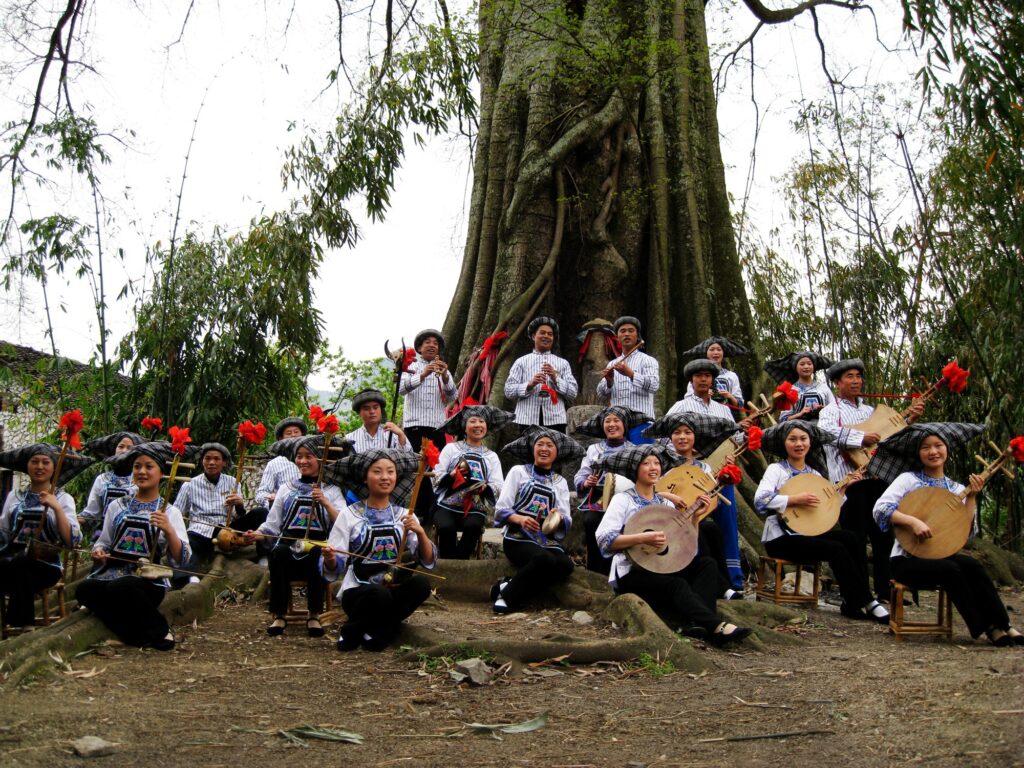
贵州 布依族八音座唱 Singing Accompanied with Eight Musical Instruments of the Bouyei People – Guizhou province

云南德宏 景颇族目瑙纵歌 Munaozongge Festival (Singing and Dancing Together) of the Jingpo People – Dehong, Yunnan province

广西宜州 刘三姐故里 Former Residence of Folk Singer Liu Sanjie – Yizhou, Guangxi province
斯堪的纳维亚民族音乐起源于即兴的音乐文化,音乐的传播依靠口耳相传,鲜少有文字记录。这一点与中国民歌具有相似的特点。演奏者自身的风格会在很大程度上改变和影响音乐,许多曲调的来源已不可考,有些风格得名于将其发扬光大的音乐家,例如约尔特·安德斯(Hjort Anders)的波尔斯卡舞曲(polska)。
Scandinavian folk music springs from an improvisational culture where the music is based on having an ear for music and oral tradition where the music is passed on and taught by listening and rarely written down, which is similar to Chinese folk music. It is played with great variations and adaptations to the practitioner’s own style and the author of individual tunes can be difficult to trace, despite terms such as “polska after Hjort Anders…”.

Vilhelm Stokstad/imagebank.sweden.se

Carolina Romare/imagebank.sweden.se

Image by Åsa Lundqvist
在斯堪的纳维亚半岛北部,传统音乐总是隐含忧郁凄然之感,也许是与那渺无人烟的广袤荒野与苍莽幽林有关。而在南部,肥沃宜居的环境也反映在更为轻松愉悦的音乐之中,例如《父亲之歌》(Song for Father)。民间颂歌,一种以民间曲调歌唱古老宗教赞美诗的音乐,婉转悠扬的旋律如刺绣般绵延流淌,成为无数现代音乐家的灵感来源。叙事曲,以歌曲讲述一段长篇故事,人们围成圆圈载歌载舞——这不仅是瑞典,也是整个斯堪的纳维亚半岛,包括冰岛和法罗群岛的风俗。有时,尤其是在法罗群岛,人们唱起叙事曲并随之舞蹈更像是一种祷文,为阻挡邪恶的降临做最后准备。此外,还有牧歌和短歌等。
In the northern part of Scandinavia, traditional music often has a melancholy undertone – perhaps formed by the vast wild nature and wide forests where there were long distances between the villages. In Southern areas with richer soil and friendlier landscape, the music is often more delightful and light-hearted – an imaginable reflection of the surrounding nature. An example is the heartbreaking ”Song for Father”. One of the many branches of Swedish folk music is folkloric corals (folkliga koraler) which is old religious psalms sung in a folk tune, the melodies are often rich of drills and sinuous like embroidery and continues to inspire many musicians today. Also ballades is very common; songs of many verses that were sung and danced in ring telling a longer story. This was a custom not only in Sweden but in whole Scandinavia, also Iceland and Faroe Islands. Sometimes and especially on the Faroe Islands they were sung and danced like an invocation and as an eventual preparation so the evilness would not happen. Other branches include dances, sheperds´ music such as vallåtar and fäbodpsalmer, shorter songs (visor) and much more.

Image by Åsa Lundqvist

Per Bifrost/imagebank.sweden.se
呼 麦 vs. 库尔宁
Khoomei vs. Kulning
呼麦是一种源于蒙古西部阿尔泰山脉的演唱形式,表演者模仿自然界的声音,同时发出两种不同的声音,是一种藉由喉咙紧缩而唱出双声的泛音咏唱技法。演唱者同时发出持续厚实的低音和透明清亮的高音,不同声部在一个人身上形成了和声。呼麦的字面意思是咽喉,据说源自对鸟类的模仿,其核心精神与萨满信仰有关。蒙古游牧民族在不同社会场合演唱呼麦,如大型仪式或家庭节日。放牧途中或在蒙古包中哄婴儿入睡,也会唱呼麦。
Khoomei is a form of singing that originated in western Mongolia, in the Altai mountains. The performer imitates sounds of nature, simultaneously emitting two distinct vocal sounds: the drone is produced with very taut vocal cords, and the melody is created by modulating the size and shape of the mouth cavity, opening and closing the lips and moving the tongue. The singer simultaneously produces a continuous drone and a clear high pitch, creating a harmonious concord with different voice parts by one person. Khoomei literally means pharynx, and it is believed to have been learned from birds, whose spirits are central to shamanic practices. Khoomei is performed by Mongolian nomads in a variety of social occasions, from grand state ceremonies to festive household events. Khoomei is also sung during herding, and inside the yurt to lull babies to sleep.
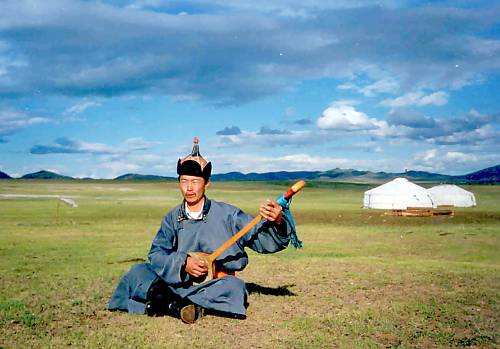
S.Yundenbat / UNESCO
视频由内蒙古民族艺术剧院提供
Video provided by Inner Mongolia Bureau of National Art Troupes
库尔宁是斯堪的纳维亚地区一种独特的唱腔。在瑞典北部,大多由女牧者以这种唱法召唤放牧于山林草地上的牛羊。她们各自独特的曲调和悠扬的高音,在几公里之外都可以听见,使畜群得以辨别并听从召唤,以及实现不同农庄之间的交流。库尔宁唱出的袅袅清音,大多透着伤感之情,源于其中融入了当地音乐中的半音和四分音。有时也会使用号类乐器。如今,库尔宁技艺依然广为传授,是瑞典民族音乐的重要部分。尽管难度很大,但是这种独特的半音曲调有着震撼人心的力量,赋予不同层次的忧郁基调。来自瑞典北部阿尔夫达伦的莉娜·威尔玛克是当代著名的库尔宁演唱者,她与阿莱·莫勒搭档,以自己独特的方言演唱,自成一格。
A very special song technique in Scandinavia is called ”kulning” and is used in the northern parts of Sweden to call for the cattle and sheep in the mountains and meadows, mostly by female shepherds. It´s a song that can be heard several kilometers away and each shepherdess had her own song so that her herd would recognize the tune and come. It was also used as communication between homesteads. The song has a high-pitched vocal technique, i.e. a loud call using head tones, so that it can be heard or be used to communicate over long distances. It has a fascinating and haunting tone, often conveying a feeling of sadness, in large part because it often includes typical half-tones and quarter-tones (also known as “blue tones”) found in the music of the region. Also instruments like different kinds of horns were used. This way of singing is still taught and is a significant part of the folk music of today. The blue tones or in-between tones are difficult to learn, though when performed it touches one’s heart and mind in a very special way that adds layers to the blue feeling. A modern master of these tunes is Lena Willemark, a singer from Älvdalen in Northern Sweden, who often plays with Ale Möller and sings in her own dialect, which is more like a language of its own.
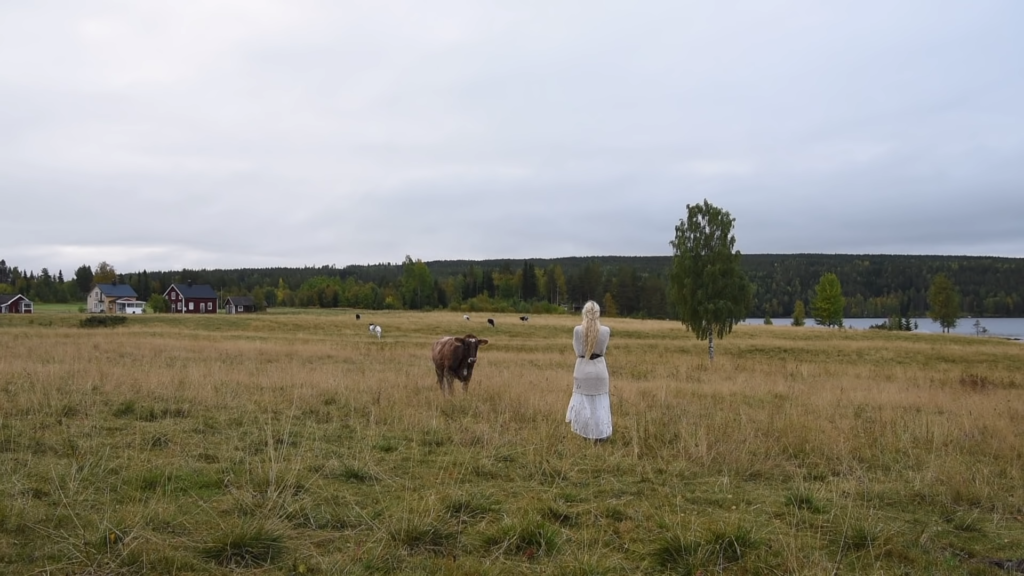

舞 曲
Dance Music
犹如世界上众多民族一样,在中国文化最初的历史时期,音乐与舞蹈一直密不可分,共同构成“乐舞”概念。至夏代,乐舞分工成为一种艺术门类而独立于社会。自此,音乐进入了夏、商、周那长达1300多年漫长而辉煌的“钟鼓之乐”时期。秦、汉之后至唐朝的1200余年间,歌舞大曲是中国音乐的主要形式。隋唐时代,佛教寺院的庙会成为平民的音乐活动园地;酒楼亦常有诗歌吟唱。尤其至宋代,“勾栏”、“瓦肆”、“戏楼”及“茶馆”等地均成为音乐舞蹈艺术演出的场所,并出现了鼓子词、杂剧、南戏等诸多音乐艺术表演形式。
Music and dance have been inseparable since the emergence of Chinese culture, similar to numerous nations in the world. Until the Xia dynasty, music and dance became an independent art category in the society, heralding the 1300-year history of splendid bell and drum music period in Xia, Shang and Zhou dynasties. During the 1200 years between Qin, Han and Tang dynasties, the grand song and dance ensemble was the major musical form. In Sui and Tang dynasties, common music was played for the public in Buddhist temple fairs and poems and songs were performed in high-end restaurants. Notably, in the Song dynasty, music and dance performances were held in theaters, entertainment centers, opera houses and tea houses, etc. New musical forms, such as guzici (drum song), zaju (poetic drama set to music) and nanxi (southern opera), emerged.
甘肃 多地舞 Duodi dance in Gansu province

贵州石阡县 仡佬毛龙节 龙腾盛世闹元宵 Maolong Festival of the Gelao People – Shiqian county, Guizhou province / 田健 Tian Jian

山东济南 商河鼓子秧歌 Drum Yangko dance in Shanghe county – Jinan, Shandong province

陕西 安塞群打腰鼓 Ansai Waist Drum Dance – Shaanxi province
中国各少数民族皆能歌善舞,他们的歌舞极富特色又极具魅力,如维吾尔族的”麦西热甫“、藏族的”锅庄舞”、纳西族的”窝热热”、侗族的”多耶”、傣族的”孔雀舞”等。
Chinese ethnic minorities are natural singers and dancers creating distinctive and appealing music and dances, such as the Uyghur’s Meshrep, the Tibetan’s Guozhuang dance, the Naxi’s Worere dance, the Dong’s Duoye dance, the Dai’s Peacock dance, etc.

贵州丹寨 锦鸡服饰 Golden Pheasant Dance Costume – Danzhai county, Guizhou province

贵州 芦笙悠扬 Celebration of Lusheng (Reed Pipe) Festival – Guizhou province

内蒙古 舞蹈 Inner Mongolian Folk Dance
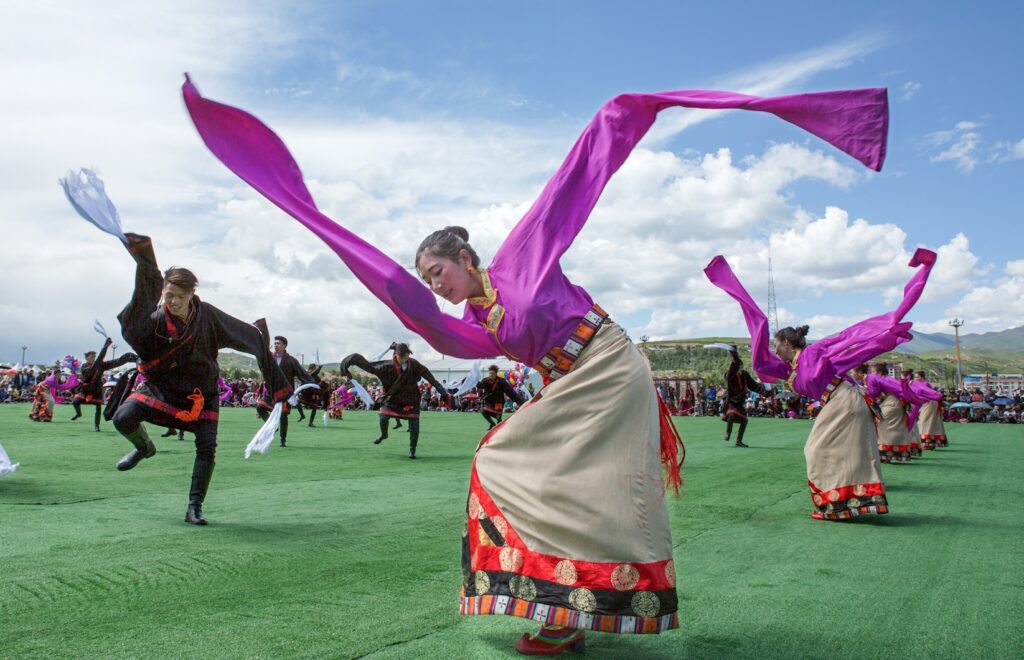
四川 扎崇节跳起锅庄舞 Guozhuang Dance in Zhachong Festival – Sichuan province / 杨志刚 Yang Zhigang
瑞典民族舞曲种类多样,以小提琴或尼古赫帕(nyckelharpa )演奏为主,节奏多由敲击而非打击乐器表示。舞蹈则包括行歌(gånglåtar)、婚礼进行曲(brudmarsch)、斯朗波尔斯卡(slängpolska)、沙蒂希步舞曲(schottis)、华尔兹(vals)、汉波(hambo)、哈林舞曲(halling)等。其中最流行的是波尔斯卡,可能起源于波兰,17世纪盛行于欧洲。人们排成不同的队列或圆圈舞蹈,后来也有演变为双人舞。
Typical Swedish folk music for dancing is played on violin or nyckelharpa and includes many different dances and rhythms, mostly without percussion, the rhythm being sensed through the strokes; gånglåtar (walking songs), brudmarsch (wedding marches), slängpolska, schottis, vals, hambo, halling etc. The most frequent amongst these dances is polish (polska) which probably came from Poland and was popular in Europe in the 1600s. The new thing it brought was couple dance, earlier one had mostly danced in long more or less complicated chains or circles.

Ola Ericson/imagebank.sweden.se

Janus Langhorn/imagebank.sweden.se
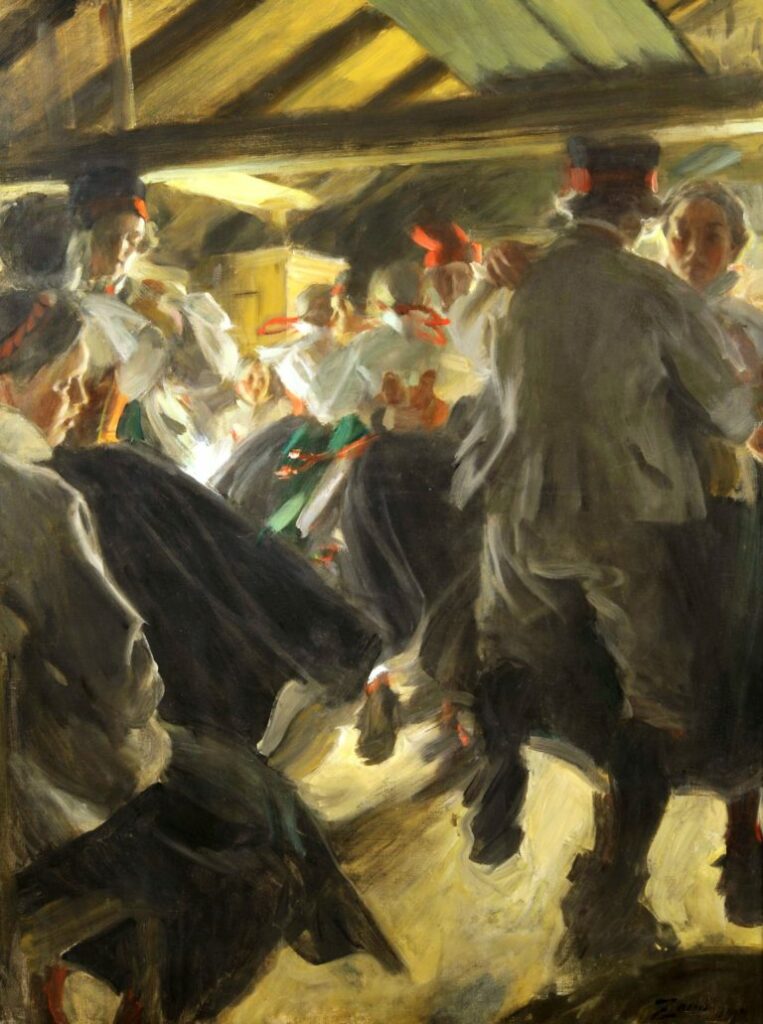
Anders Zorn Tanz in der Gopsmorkate 1914
乐 器
Musical Instruments
中国民族乐器是中国音乐必不可少的组成,经数千年发展形成了品种众多,曲目丰繁的态势,大致可分为以下四类:(1)吹管乐器:笛、笙、箫、唢呐等;(2)弹拨乐器:古琴、琵琶、三弦、筝等;(3)打击乐器:扬琴、鼓、锣、钹等;(4)拉弦乐器:二胡、板胡、马头琴等。
As a vital part of Chinese music, Chinese musical instruments encompass a wide range of varieties developed in its thousands of years of history, which mainly fall into four categories: (1) wind instrument: flute, sheng (reed pipe), xiao (vertical bamboo flute), suona horn, etc.; (2) Plucked string instrument: guqin (seven-stringed Chinese zither), pipa (four-stringed Chinese lute), sanxian (three-stringed plucked instrument), zheng (Chinese plucked board zither); (3) percussion instrument: yangqin (Chinese struck zither), drum, gong, cymbal, etc.; (4) stringed instrument: erhu (two-stringed Chinese vertical fiddle), banhu ( bowed Chinese fiddle), morin khuur (horsehead fiddle), etc.
古琴 Guqin / UNESCO

江苏省文化和旅游厅 Jiangsu Provincial Department of Culture and Tourism
四川省文化和旅游厅 Sichuan Provincial Department of Culture and Tourism
小提琴是瑞典最重要的乐器之一,也使用笛子、号以及吉他、簧风琴等现代乐器,一般不使用打击乐器。小提琴的姊妹乐器是瑞典民族乐器尼古赫帕,一种有键提琴。还有更为古老的手摇琴,通过转动乐器上的手柄,联动腹腔内的轮子摩擦琴弦发声,类似小提琴的琴弓。
There are a great variety of musical instruments in Sweden amongst which the violin is by far the most important, while several kinds of flutes, horns and modern instruments such as guitar, harmonium etc. are also commonly used. A sister instrument to the violin is nyckelharpa, a keyed fiddle, and an older version is vevlira, which produces sound by a hand crank-turned wheel rubbing against the strings, much like a violin bow.

尼古赫帕 Nyckelharpa / Eric_Sahlstrom

尼古赫帕 Nyckelharpa / Louvet Drehleier
保护与传承
Preservation and Development
20世纪,东西方文化交汇冲撞,中国音乐艺术掀开了波澜壮阔的崭新一页。如今,中国音乐与西方等外来民族音乐的交流融汇深刻影响着中国的音乐创作、表演、音乐教育、音乐理论,乃至音乐出版、音乐市场等音乐艺术的一切领域,由此形成了新时期音乐文化建设大发展、大繁荣的光辉景象。
The 1900s marks a time of fusion of Eastern and Western culture, and consequently, a new chapter of Chinese music. In the current context, exchange and integration with foreign folk music continues to play a profoundly important role in various fields of Chinese music, including music creation, performance, education, theory, publication and marketing, etc., contributing to the development and prosperity of Chinese music in the new era.
侗族大歌 Grand Song of the Dong Ethnic Group / UNESCO

贵州 侗族大歌 Grand Song of the Dong Ethnic Group – Guizhou province / 韦德刚 Wei Degang
北京舞蹈学院舞剧《国风》选段 Dance performance Guofeng by Beijing Dance Academy
20世纪初,许多音乐学者希望保护瑞典民俗遗产,并投入大量工作录制、记录口耳相传的民族歌曲。编舞者也基于民族舞蹈和歌曲的启发,创作了用于舞台表演的音乐舞蹈。传统的音乐,通过与民间舞蹈略有不同的方式呈现出来。
During the early 1900s, many Swedish music scholars wanted to protect the folk heritage and performed extensive work on recording and writing down folk songs from the oral tradition. Choreographers were also inspired by folk dances and songs, and created music and dance for scenic use. The melodies are traditional songs but the way of playing may differ slightly from that to the folkloric dances.
如今,瑞典民族音乐的表达愈发多样,并受到爵士、世界音乐、流行和摇滚乐的影响。音乐人、作曲家的队伍日益庞大,民族音乐教育也在中学和大学得到推广。每年,各种民族音乐节和活动层出不穷,包括Falun民族音乐节、Urkult音乐节、Umefolk音乐节、Korrö民族音乐节等。同时,丰富多彩的民族舞蹈也吸引着各年龄段的爱好者。
Today’s expressions in folk music in Sweden take on many different shapes and are influenced by jazz, world music, pop and rock. Folk music in Sweden is experiencing an upswing with a big variety of groups, composers and educations in folk music at universities and folk high schools. Many folk music festivals and events are organized every year, including Falun Folk Music Festival, Urkult, Umefolk, Korrö Folk Music Festival etc. Also the popular and various folk dance scenes throughout the country attract people of all ages for dancing and listening.

Stockholm Folk Festival / Lena Willemark Feat Alvdalens Elektriska
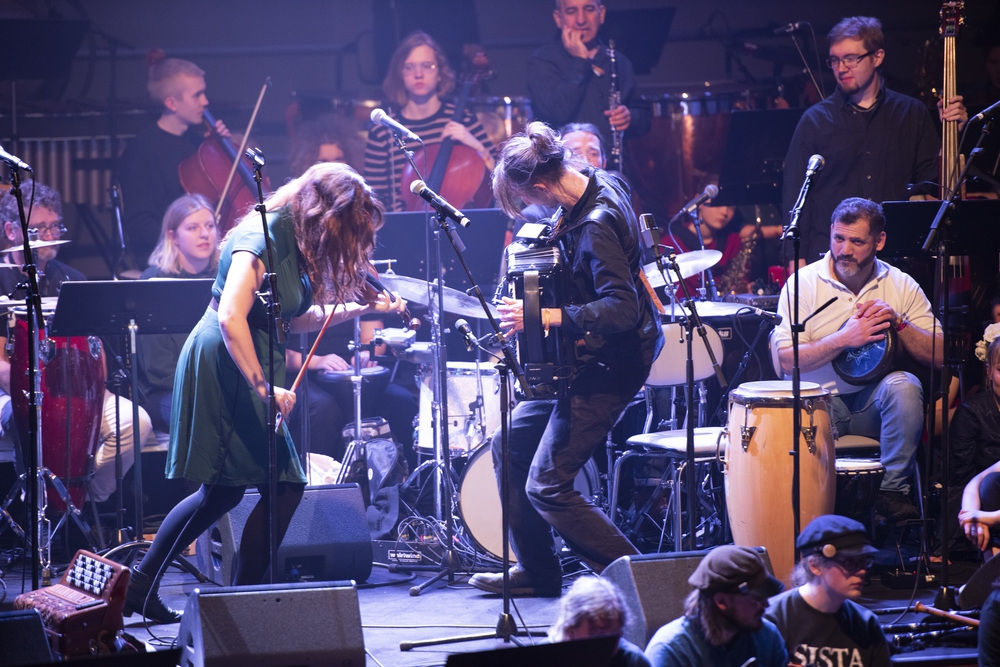
Umefolk Festival / umefolk.com

Korrö Festival / www.korrofestivalen.se

Urkult Folk Festival / Katarina Norström_www.urkult.se
资料来源/Sources:
https://www.mct.gov.cn/
https://en.unesco.org/
https://zh.unesco.org/
https://www.britannica.com/
湖南省文化和旅游厅
贵州省文化和旅游厅
云南省文化和旅游厅
广西壮族自治区文化和旅游厅
山东省文化和旅游厅
陕西省文化和旅游厅
内蒙古自治区文化和旅游厅
四川省文化和旅游厅
江苏省文化和旅游厅
《非物质文化遗产在中国》 2017
Nilsson, Mats (2009). Polska på svenska
Björk, Monika (2009). Passion : om folkmusik och dans.
Ling Jan, Ahlbäck Gunnar, red (1980). Folkmusikboken. Stockholm: Prisma
http://www.hemlandssanger.se/folkmusik.html
Dahlsmtrö, Kajsa & McAllister, Anita (June 2019). “An acoustic analysis of Swedish cattle calls, ‘kulning’, performed outdoors at three distances” (PDF).
Proceedings of FONETIK. Stockholm, Sweden: Stockholm University.
PERILUS (XXVII): 61–66. doi:10.5281/zenodo.3246001. ISSN 0282-6690. Retrieved 5 October 2019.
http://www.ungatankarommusik.se/medlemmar/sara-parkman-violinist/
https://www.ransatersstamman.nu/
Facebook: China Cultural Center in Stockholm
https://www.facebook.com/China-Cultural-Center-in-Stockholm-110983273921638
Instagram: chinaculturalcenterinstockholm
https://www.instagram.com/chinaculturalcenterinstockholm/
Tik Tok: cccinstockholm
@cccinstockholm
Wechat: 斯德哥尔摩中国文化中心 or scan the QR code below

